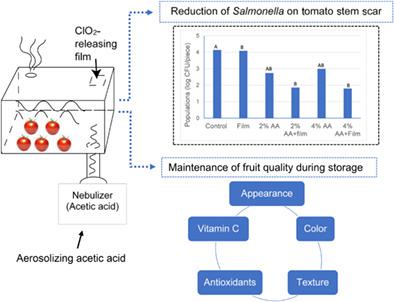当前位置:
X-MOL 学术
›
J. Food Saf.
›
论文详情
Our official English website, www.x-mol.net, welcomes your
feedback! (Note: you will need to create a separate account there.)
Combination of aerosolized acetic acid and chlorine dioxide-releasing film to inactivate Salmonella enterica and its effect on quality of tomatoes and Romaine lettuce
Journal of Food Safety ( IF 1.9 ) Pub Date : 2021-07-26 , DOI: 10.1111/jfs.12922 Xuetong Fan 1 , Tony Jin 1 , Jessica Baik 1 , Joshua B. Gurtler 1 , Sudarsan Mukhopadhyay 1
Journal of Food Safety ( IF 1.9 ) Pub Date : 2021-07-26 , DOI: 10.1111/jfs.12922 Xuetong Fan 1 , Tony Jin 1 , Jessica Baik 1 , Joshua B. Gurtler 1 , Sudarsan Mukhopadhyay 1
Affiliation

|
Novel intervention technologies are needed to minimize pathogen contamination of fresh produce. The present study was undertaken to develop an in-package treatment system that combined aerosolized acetic acid (AA) and chlorine dioxide (ClO2)-releasing film in which the acid triggered the release of ClO2 from its precursor. A four-strain cocktail of Salmonella enterica (S. Montevideo, S. Typhimurium, S. Newport, and S. Saint-paul) was inoculated onto the surfaces of cut Romaine lettuce and the stem scars of cherry tomatoes. The inoculated samples were placed into clamshell containers containing one ClO2-releasing film (2.5 × 2.5 cm). After the packages were sealed, AA (2 and 4%) was aerosolized for 60 s into the packages through perforated openings. Results demonstrated that the combination of AA with the ClO2-releasing film significantly reduced Salmonella populations with reductions of >4 log and >2 log CFU/piece on lettuce and tomato stem scars, respectively. The ClO2-releasing film or aerosolized AA alone did not result in any significant reductions of Salmonella populations except aerosolized 4% AA, which achieved 2.21 log CFU/piece reductions on lettuce. The combinations and 4% AA treatment caused damage to fresh-cut lettuce during 14 days of storage as evidenced by the deterioration in appearance, softening, and decreased ascorbic acid and antioxidant levels. The treatments did not significantly affect most of the quality attributes of cherry tomatoes during 21 days of storage at 10°C. Overall, our results demonstrate that the novel combination of AA and ClO2-releasing film may be used to enhance microbial safety and quality of cherry tomatoes.
中文翻译:

雾化醋酸与二氧化氯释放膜联合灭活肠道沙门氏菌及其对番茄和罗马生菜品质的影响
需要新的干预技术来最大限度地减少新鲜农产品的病原体污染。本研究旨在开发一种包装内处理系统,该系统结合了雾化乙酸 (AA) 和二氧化氯 (ClO 2 ) 释放膜,其中酸触发了 ClO 2从其前体中释放。将肠道沙门氏菌(S. Montevideo、S . Typhimurium、S . Newport 和S. Saint-paul)的四株混合物接种到切好的长叶莴苣的表面和樱桃番茄的茎痕上。将接种的样品放入装有一 ClO 2 的蛤壳式容器中- 离型膜(2.5 × 2.5 厘米)。包装密封后,AA(2% 和 4%)通过穿孔开口雾化到包装中 60 秒。结果表明,AA 与 ClO 2释放膜的组合显着减少了沙门氏菌种群,生菜和番茄茎疤痕上的沙门氏菌数量分别减少了 >4 log 和 >2 log CFU/片。单独的 ClO 2释放膜或雾化 AA 不会导致沙门氏菌的任何显着减少除雾化 4% AA 外,生菜上的 4% AA 减少了 2.21 log CFU/片。组合和 4% AA 处理在 14 天的储存期间对鲜切生菜造成损害,这可以通过外观变质、软化以及抗坏血酸和抗氧化剂水平降低来证明。在 10°C 下储存 21 天期间,这些处理并未显着影响樱桃番茄的大部分质量属性。总的来说,我们的结果表明 AA 和 ClO 2释放膜的新型组合可用于提高樱桃番茄的微生物安全性和质量。
更新日期:2021-07-26
中文翻译:

雾化醋酸与二氧化氯释放膜联合灭活肠道沙门氏菌及其对番茄和罗马生菜品质的影响
需要新的干预技术来最大限度地减少新鲜农产品的病原体污染。本研究旨在开发一种包装内处理系统,该系统结合了雾化乙酸 (AA) 和二氧化氯 (ClO 2 ) 释放膜,其中酸触发了 ClO 2从其前体中释放。将肠道沙门氏菌(S. Montevideo、S . Typhimurium、S . Newport 和S. Saint-paul)的四株混合物接种到切好的长叶莴苣的表面和樱桃番茄的茎痕上。将接种的样品放入装有一 ClO 2 的蛤壳式容器中- 离型膜(2.5 × 2.5 厘米)。包装密封后,AA(2% 和 4%)通过穿孔开口雾化到包装中 60 秒。结果表明,AA 与 ClO 2释放膜的组合显着减少了沙门氏菌种群,生菜和番茄茎疤痕上的沙门氏菌数量分别减少了 >4 log 和 >2 log CFU/片。单独的 ClO 2释放膜或雾化 AA 不会导致沙门氏菌的任何显着减少除雾化 4% AA 外,生菜上的 4% AA 减少了 2.21 log CFU/片。组合和 4% AA 处理在 14 天的储存期间对鲜切生菜造成损害,这可以通过外观变质、软化以及抗坏血酸和抗氧化剂水平降低来证明。在 10°C 下储存 21 天期间,这些处理并未显着影响樱桃番茄的大部分质量属性。总的来说,我们的结果表明 AA 和 ClO 2释放膜的新型组合可用于提高樱桃番茄的微生物安全性和质量。









































 京公网安备 11010802027423号
京公网安备 11010802027423号